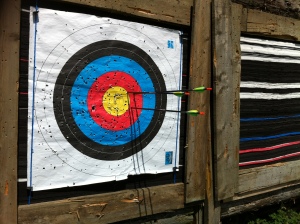
For those that don't know, field archery is a bit of a confusing name for the sport, because the name implies standing in a field and shooting at set targets - like you might have seen on the Olympics. If you thought that you would be wrong, that's Target Archery.
Field Archery is the closest you can get to bow hunting while in the UK. It usually takes place in woodlands, over a course (I used to think it was called 'Course Archery' for this reason) of twenty or so assorted animal-shaped targets at varying ranges.
It's illegal to hunt / kill ANYTHING with a bow and arrow in this country - unless you're in the City of York, within the city walls, and your target is a Scotsman who happens to be carrying a bow and arrow...
Aside from that one bizarre law hunting and shooting at anything living will land someone in the UK with a hefty fine and / or imprisonment. So no bow-hunting and no bow-fishing for us Brits.
Now we've cleared that up...
We started with a couple of hours on the 'practice butts'. This got us used to the bows and how to shoot at varying distances. The targets on the practice butts were typical target archery targets, with markers every 5 yards from 15 yards out to 70 yards.
It was during this warm up that our tutor / guide, Ryan, told us that the rings on the targets were trying to put us off; the centre ring being gold / yellow calls for your attention, but the ring adjacent to it being red was causing the instinctive part of our brains to react to danger.
This appears to be backed up by pschology where tests have shown that in cognitive tests the colour red showed reduced responses. In other tests red has shown to boost adrenaline levels - another sign of the more primal fight or flight response. Both of these could (I couldn't find anything to back this part up) add to innaccuracy in some circumstances for target shooters.
We took a break for a genial chat, Ryan is quite a talker, and I got to know the other half dozen guys with us. They have two 20 target courses on their site, and we were told it was probably the toughest course in the UK. This did not fill me with confidence for not losing any arrows.
However off in to the woodland we went, and I managed to mail the first target with my first arrow. This deffinitely bolstered my confidence for the rest of the course.
The course wan't just single targets; there 'Herd' targets - two or even three of the same type (Boars, Hares etc) where the idea is to hit the furthest one and while the others are looking away from you (at the one you hit) you take out the others, then there are 'predator - prey' targets where ou have to shoot the predator before you shoot the prey (so the targets are like a mountain lion and a turkey and you have to shoot the mountain lion before you can shoot the turkey).
Then to complicate things, this site (I don't know about others) has replicated a couple of 'Tree Stands' - elevated shooting platforms similar to those used by American hunterrs, which add another level of difficulty to the shot because you're well above your target.
We finished the 20 target course and thankfully I didn't lose a single arrow. I didn't score on every target but I was close enough to satisfy my ego.
Then to finish the day we did some ranging shots, or what Ryan called 'war shots' - whereby we'd go to their open field and shoot the bows angled up at around 45 dgrees to get maximum range on the arrow. given that their field was spattered with target dummies in medieval get-up it was easy to see how archery affected the battles of that era - it wasn't accuracy of shot that won the day - it was volume of arrows, and the fact that before the batle the archers had time to pop out to the field and drop range markers on the ground so they knew where to aim for any given target.
Interesting (well I found it interesting) trivia:
- You do not 'fire' a bow, you shoot it.
- Arrows are 'Loosed'.
- Medieval arrows didn't have the tips glued on, so if the tip didn't come out the other side of the target, it would stay in the target when the arrow was removed.
- Before battle archers would dip their arrow tips in their army's latrine holes to ensure infected wounds in their enemy.
No comments:
Post a Comment